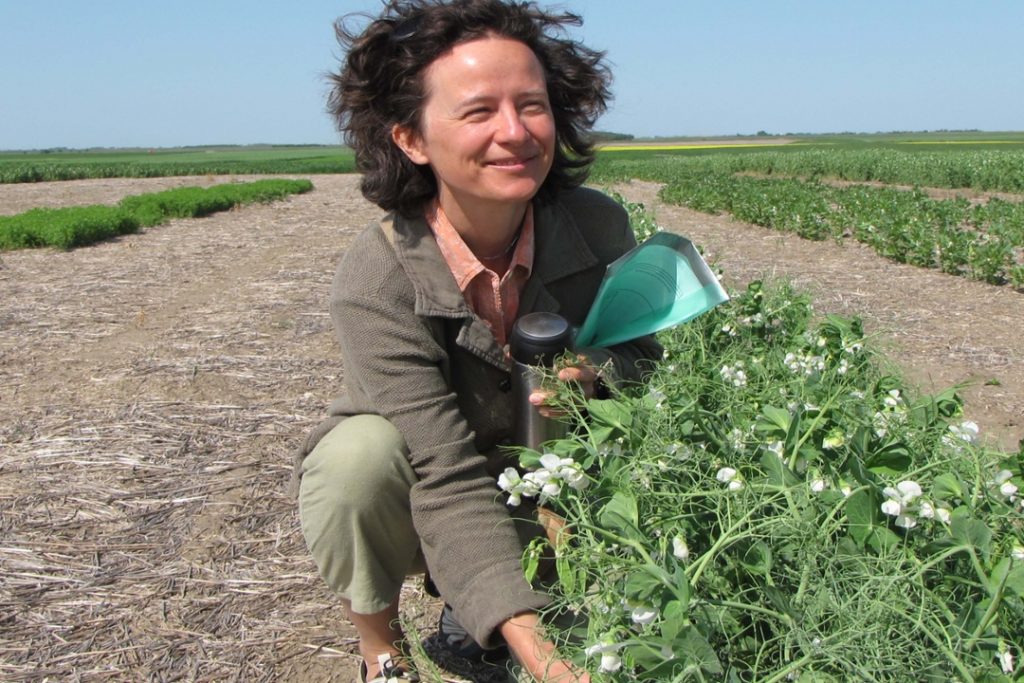
News
Fruit
Research
USask crop researchers awarded $8M to advance food and bio-products
Saskatoon berries get a boost as a project hopes to use the berries in anti-oxidant-rich nutritional supplements.
January 27, 2020 By University of Saskatchewan
 USask pulse researcher Sabine Banniza examines a healthy pea plant at a University of Saskatchewan research site in Saskatoon. Photo courtesy of University of Saskatchewan.
USask pulse researcher Sabine Banniza examines a healthy pea plant at a University of Saskatchewan research site in Saskatoon. Photo courtesy of University of Saskatchewan. Thirty University of Saskatchewan (USask) crop research projects have been awarded a total of more than $8 million through Saskatchewan’s Agricultural Development Fund (ADF), a program jointly supported by the federal and provincial governments and supplemented by industry partners.
“This major funding commitment from our partners will address critically important crop challenges to help create a prosperous and sustainable future for Saskatchewan producers and communities, while helping to strengthen Canada’s agricultural sector and feed a hungry world,” said USask Vice-President, Research, Karen Chad.
The ADF program is supported through the Canadian Agricultural Partnership, a five-year $388 million investment by the federal and provincial governments in strategic initiatives for Saskatchewan agriculture.
One project will see haskap (also known as edible blue honeysuckle) and Saskatoon berries turn into anti-oxidant-rich nutritional supplements.
USask food scientist Nicholas Low will identify phenolics—compounds known to have anti-oxidant, anti-cancer and anti-inflammatory properties—in the pulp of Saskatchewan-grown and bred haskap berries. The phenolics have many potential commercial applications, ranging from health supplements, to food additives and colorants, to fighting cancer.
Other major projects announced Jan. 14 involving USask researchers include:
- Identifying potato varieties that reduce environmental impact and cost: USask plant scientist Kate Congreves will test modern potato cultivars for improved nitrogen and phosphorous efficiency. Potatoes are the single most important vegetable crop in Canada and comprise a third of all vegetable income for farmers nationally. By identifying the best potato varieties to grow in Saskatchewan, farmers can boost yields, increasing revenue, and reduce fertilizer use, decreasing costs and improving soil quality.
- Using pulse proteins to replace animal products in the beverage industry: USask food research Supratim Ghosh will study new ways to extract proteins from pulses for use as beverage industry additives. Using plant proteins can improve digestibility and shelf-life for beverages. Ghosh’s proposed method could reduce both environmental impact and cost.
- Adding value to Saskatchewan’s lentils, peas and oats: USask protein researcher Mike Nickerson will develop new meat alternatives by fermenting a combination of lentils, peas and oats. Tempeh, a protein-rich and cake-like food traditionally made from fermented soybeans, lacks some essential amino acids. Blending pulses with oats shows promise in creating a “complete” protein that is not only high in protein and fiber, gluten- and soy-free, but also tasty and commercially competitive.
Industry funding for projects involving USask is provided by a wide range of organizations and agencies including Western Grains Research Foundation, Saskatchewan Wheat Development Commission, Saskatchewan Forage Seed Development Commission, Saskatchewan Cattlemen’s Association, Saskatchewan Canola Development Commission, Saskatchewan Flax Development Commission, Canadian Wheat Research Coalition, Genome Canada, Alberta Wheat Development Commission, and the Manitoba Wheat Development Commission.
Print this page